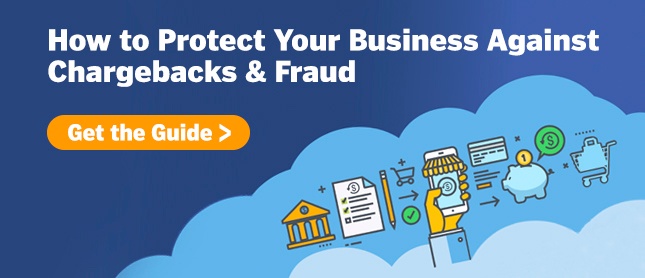
Understanding and Preventing Friendly Fraud & Chargeback Fraud
By Brian Radford on May 27, 2021
Fraud is significant source of chargebacks and it is on the rise. According to the Federal Trade Commission, overall payment card fraud rose over 104% between the first quarter of 2019 and the first quarter of 2020. Fraud is not a single, monolithic category, though. LexisNexis’s 2016 True Cost of Fraud found that friendly fraud and chargeback fraud constituted a larger percentage of fraud losses than true fraud.
Understanding the consequences of these statistics requires understanding what, exactly, friendly fraud and chargeback fraud are. While they are both distinct from true fraud— intentional fraud committed by criminals with stolen or fraudulent payment information—they are both complex problems on their own. In fact, while some may consider “friendly fraud” and “chargeback fraud” to be synonyms, we find it more useful to treat them as distinct, if related, concepts. Understanding how these forms of fraud affect your business requires understanding those distinctions.
What is Friendly Fraud?
As defined in our Payments Industry Glossary, friendly fraud occurs “when a customer requests a chargeback for a relatively innocuous reason, such as a family member making a purchase without the customer realizing, the customer genuinely forgetting that they had made a purchase, or some mistake relating to the customer not understanding something such as a return policy.” Under this definition, friendly fraud is not an intentional attempt to defraud a merchant. However, just because friendly fraud may be unintentional does not mean it is harmless.
Friendly fraud generally arises as a result of consumer confusion. Some aspect of the transaction renders it unrecognizable to the consumer, leading them the contact their bank to file a chargeback. Examples of such sources of confusion include:
-
Unclear billing descriptors or lack of transaction detail
-
Unrecognizable merchant identifiers
-
Purchases made accidentally through the internet of things
-
Accidental or unrecognizable in-app purchases
-
Purchases made by a family member unbeknownst to the cardholder (this is known as family fraud)
The key hallmark here is that the cardholder genuinely believes that a fraudulent purchase has been made on their card, necessitating a chargeback.
What is Chargeback Fraud?
Chargeback fraud is when a customer requests a chargeback knowing that they have no valid claim to one. It is a knowing abuse of the consumer protection mechanisms that exist within the retail and financial regulatory infrastructure by a payment cardholder for their own nefarious purposes. Chargeback fraud takes advantage of changes to financial regulations since the passage of the Dodd–Frank Wall Street Reform and Consumer Protection Act in 2010 that make it significantly easier for consumers to request chargebacks.
Chargeback fraud is distinct from friendly fraud in its intentionality. Rather than being confused and believing fraud had been committed, the chargeback fraudster is knowingly, falsely claiming fraud. In this way, they are able to receive the goods or services while still having their payment returned— essentially a form of digital shoplifting.
How Friendly & Chargeback Fraud Can Threaten Your Business
Both friendly fraud and chargeback fraud can significantly harm your business. At the most basic level, you will lose the revenue of the returned payment and likely the product itself. You will also have to pay chargeback fees. Even if you successfully fight the chargeback, you will not recoup all of your expenses because of chargeback fees and operating costs. Payment solutions provider Ethoca estimates that 60% of merchants’ chargeback costs are from operational costs and that every chargeback costs the merchant, on average, 2.5 times the cost of the original transaction.
There are even greater potential consequences if friendly fraud and chargeback fraud lead to excessive levels of chargebacks. Merchant accounts may be cancelled if your chargeback ratio exceeds 1% and, even worse, you may be put on the MATCH List, a Terminated Merchant File that essentially blacklists you from opening any new merchant accounts for 5 years. These consequences are especially dangerous because your chargeback ratio is calculated on how many chargebacks are filed with no regard paid to successfully disputed chargebacks.
Chargebacks carry other, less quantifiable but real detriments, as well. Friendly fraud, in particular, can damage your brand. Consumers who mistakenly believe that fraud is occurring through your retail establishment could end up holding a negative opinion of your business—potentially even more so if their chargeback is successfully disputed. And in this era of online reviews, ratings, and message boards, consumer dissatisfaction can become a branding problem very easily.
Additionally, responding to chargebacks and trying to manage chargeback fraud after the fact can drain time and resources better spent on your business itself. A problem with recurring chargeback fraud can easily draw your business into a morass of representments, customer service efforts, and other chargeback response projects that will weigh you down. When it comes to friendly fraud and chargeback fraud, the old adage applies: an ounce of prevention is worth a pound of cure.
What is the merchant's obligation when a transaction is made with all the correct information and authentication checks?
When a transaction is made with all the correct information and authentication checks, it is not the merchant's obligation to bear the chargeback hit on behalf of the customer. In such cases, where the transaction is legitimate and properly authenticated, merchants should assert their rights and fight back against the chargeback by presenting the necessary evidence to the issuing bank. By standing up against unjustified chargebacks, merchants can protect their interests and ensure that they are not unfairly penalized for legitimate transactions.
What evidence and documentation should merchants submit to the issuing bank as evidence to prove the legitimacy of the transaction and delivery of the product or service?
Merchants should submit receipts and other relevant documentation to the issuing bank as evidence to prove the legitimacy of the transaction and delivery of the product or service. This can include order details, shipping information, delivery confirmation, customer communication records, and any other supporting evidence that verifies the transaction and shows that the cardholder authorized and received the purchased goods or services. The more comprehensive and detailed the documentation, the stronger the case against the friendly fraud chargeback.
How can merchants fight back against friendly fraud chargebacks?
Merchants can fight back against friendly fraud chargebacks by thoroughly documenting each order they receive. This includes keeping records of receipts, transaction details, and any other relevant evidence that proves the transaction was authorized by the cardholder and the product or service was delivered. Merchants should submit this documentation to the issuing bank as strong evidence to support their case against the chargeback. By providing comprehensive and convincing documentation, merchants can increase their chances of successfully fighting friendly fraud chargebacks.
What is the recommended approach for preventing family fraud and how does it benefit the merchant?
The best approach to prevent family fraud is to issue refunds instead of allowing chargebacks. By promptly providing refunds, merchants can avoid the high costs associated with chargebacks. Furthermore, issuing refunds demonstrates that the merchant cares about their customers and takes a compassionate approach towards the challenges many parents face. This approach helps to maintain a positive reputation and build trust with customers.
How can merchants prevent different types of friendly fraud, such as malicious chargebacks, chargebacks caused by customer confusion, and friendly fraud caused by bad customer experiences?
To prevent malicious chargebacks, merchants can maintain a blacklist of customers who have a history of filing chargebacks. This helps to identify repeat offenders and can be used to deny their transactions. To prevent chargebacks caused by customer confusion, merchants should ensure that their billing descriptors match the customer-facing name of the business. Additionally, including a customer service phone number on statements can encourage confused customers to contact the merchant before contacting their bank. To prevent friendly fraud caused by bad customer experiences, prioritizing customer satisfaction is crucial. Merchants should focus on providing a positive experience, ensuring customers do not feel deceived or taken advantage of. Having a generous refund policy can also prevent refund requests from escalating into chargebacks.
Are there parents who choose to dispute charges instead of implementing proper parental controls?
Unfortunately, there are some parents who decide that disputing charges with their bank is easier than maintaining effective parental controls on their devices. This implies that some parents may resort to friendly fraud as a means to avoid taking responsibility for their lack of proper control measures.
What is the likelihood of friendly fraudsters becoming repeat offenders?
According to some analysts, as many as 83% of friendly fraudsters become repeat offenders. This suggests that a significant portion of those who engage in friendly fraud continue to perpetrate fraudulent activities repeatedly.
What is the difference in perspectives between issuing banks and merchants regarding friendly fraud rates?
Issuing banks report that friendly fraud accounts for 17% of the chargebacks they see, while merchants report the number to be as high as 32%. This indicates a difference in viewpoints between banks and merchants regarding the prevalence of friendly fraud.
Prevention Begins with Understanding Your Payment Ecosystem
There is no “one size fits all” solution to either friendly fraud or chargeback fraud, let alone one that covers both. Maintaining a chargeback prevention plan focused on reducing friendly fraud and chargeback fraud can be incredibly complex.
Designing procedures to prevent friendly fraud can involve such topics as modifying billing descriptors, designing guardrails in payment systems to prevent unintentional purchases and family fraud, and emphasizing customer service in such a way as to induce cardholders to resolve disputes with you rather than via chargebacks. Preventing chargeback fraud involves things like recognizing patterns that may indicate fraud before a transaction can be completed, identifying cardholders with a history of filing for suspicious chargebacks, and other such actions.
There are also technological methods for reducing the likelihood of chargeback fraud and friendly fraud, including chargeback alerts, automated chargeback aversion tools, and other tools to share transaction information. But maintaining all of these different efforts—as well as any strategies to combat true fraud—can be difficult to manage while also trying to run a business. The most valuable solution for reducing your susceptibility to chargeback fraud and friendly fraud would be one that combines all these features into a single, easy-to-use package.
What are the future implications of friendly fraud?
Friendly fraud is a persistent issue in the world of commerce that is unlikely to disappear in the foreseeable future. The proactive steps taken by bad actors to exploit the chargeback system, coupled with the presence of confused customers and those willing to do whatever it takes to obtain refunds, ensure that friendly fraud will remain a concern for businesses. While certain industries, such as game publishers, may be able to implement adjustments to mitigate the problem of unauthorized in-app purchases made by children, the broader implications of friendly fraud demand a comprehensive approach.
Merchants across various sectors must prioritize the delivery of excellent customer service, especially to customers who reach out with concerns or problems. By promptly addressing and resolving issues, businesses can create an environment of trust, encouraging customers to seek assistance directly rather than resorting to chargebacks. This approach not only minimizes the potential for friendly fraud but also fosters stronger relationships with customers based on transparency and reliability.
Additionally, merchants should equip themselves with the knowledge and tools necessary to effectively combat friendly fraud chargebacks when they do occur. Employing robust fraud detection and prevention mechanisms, such as advanced data analytics and monitoring systems, can enable businesses to identify fraudulent activity promptly. By challenging chargebacks where appropriate, businesses can reduce the financial impact of friendly fraud and discourage individuals from taking advantage of the system in the future.
Looking ahead, it is crucial for industry stakeholders to collaborate and develop innovative solutions to address the evolving tactics employed by fraudsters. Sharing best practices, industry standards, and strategies for fraud prevention can provide businesses with valuable insights and enable them to stay one step ahead of friendly fraud. Furthermore, ongoing education and awareness initiatives can empower customers to make informed decisions, reducing the likelihood of unintentional friendly fraud occurrences.
While friendly fraud remains an ongoing challenge, there are steps businesses can take to mitigate its impact. By prioritizing exceptional customer service, implementing effective fraud detection measures, and fostering industry collaboration, merchants can navigate the ever-evolving landscape of friendly fraud and safeguard their interests while maintaining customer satisfaction.
Protecting Your Business from All Varieties of Chargebacks
MidMetrics provides just such a package: a full suite of our own proprietary chargeback management tools (including Management Dashboards, In-Depth Analytics Tools, and On-Demand Reports). This gives you a comprehensive platform for preventing friendly fraud and chargeback fraud along with monitoring the health of all your merchant accounts for one all-inclusive price.
Instead of trying to design a fraud prevention strategy by putting together a patchwork of chargeback services from various providers—or trying to build your own setup from scratch—you can purchase them all together in one seamlessly integrated package.
MidMetrics is expertly designed to be easy to use, and it requires minimal IT effort for merchants to implement. It integrates with payment processors, gateways, CRMs, and service providers via API, and uses secure credentials to establish direct connections with card networks and banks. On the user end, MidMetrics automatically gathers and aggregates relevant data from all available sources, normalizing and presenting it in readable reports that present clear and actionable insights to merchants.
Want to see MidMetrics in action? Book a demo with one of our chargeback specialists today.
A solid chargeback protection plan is essential, but what is a good chargeback protection? What components does it need to have, and how can you tell if they’re working effectively? We’ve got answers for you in this helpful guide, How to Protect Your Business Against Chargebacks & Fraud.



